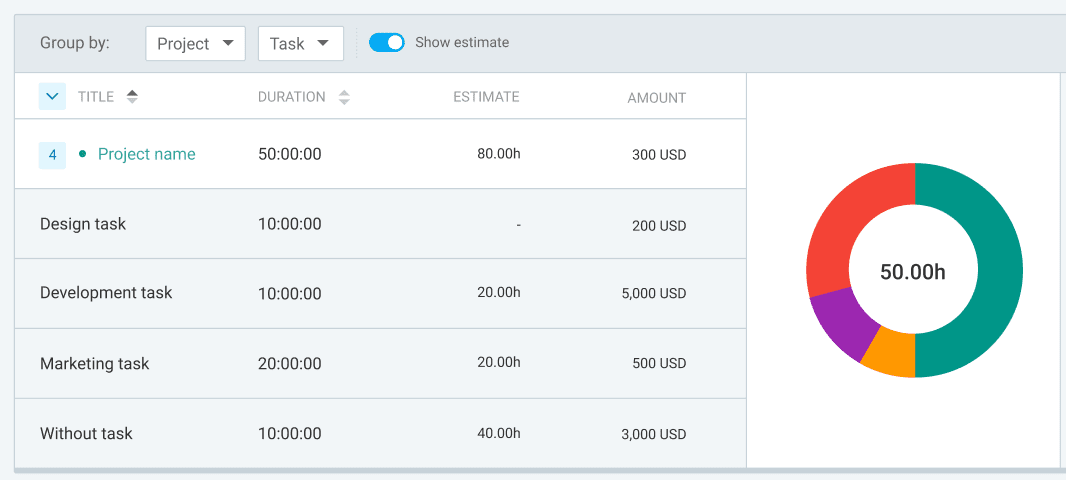How to set and reach your daily targets
Last updated on: May 24, 2023
Setting daily goals is beneficial in all aspects of your life, such as work, studying, and personal life. In this article, we’ll explore:
- the benefits of setting daily goals,
- what to have in mind when setting goals, and
- practical tips on how to reach your daily targets.
For instance, during my senior year of high school, I was determined to major in journalism. I did some research and found what I had to prepare for my entrance exam. Since this exam covered several subjects, I realized that I’ll need up to four months of studying. Each month I focused on a different subject. To reach these monthly goals, I needed consistency and a specific plan for every day. So, I would spend an hour or two studying a lesson every evening. Even though this routine was quite exhausting, having daily targets helped me achieve monthly goals. Therefore, I managed to get into the college that I wanted.

Table of Contents
The benefits of setting daily targets
Before we show you how to successfully reach your daily targets, we’ll explore why you should set these goals in the first place.
Setting daily targets makes you productive and accountable
According to the study conducted at the Dominican University in California, there are 42% chances you’ll reach your goals if you write them down. This applies to your daily goals, too.
The reason is simple – when you jot down your goals for a day, you have a visual reminder of what you need to complete by the end of the day. Thus, you’ll feel responsible to accomplish all the goals for the day.
Setting daily targets helps you keep track of your overall progress
Let’s say that your goal is to lose 20 pounds in two months. You have an entire plan of various workouts and diets for each day. So, in order to achieve that goal, you’ll need to follow your weight loss routine every day. These daily targets will ensure you reach your goal.
Moreover, having daily goals will help you monitor your progress. In the case of losing weight, this means measuring your body weight once per week. Then, if you’re not happy with your progress, be sure to modify your daily targets. If you’re satisfied with your current results, then you’ll be motivated to carry on.
Setting daily targets prevents you from procrastinating
Sometimes you don’t feel like doing tasks you should be doing, so you procrastinate. One way to avoid procrastination is to set your daily goals.
If you think of your daily targets as part of your long-term goal, then every day counts. Reaching the goals you set for one day will bring you closer to the finish line (larger goal). So, you’ll be motivated to continue with the work you’ve done so far, and you’ll focus on completing your daily goals.
What to have in mind when setting daily targets
Here are some general guidelines for setting your daily goals:
Try not to set too many goals per day
How many goals are too many? Well, that depends on the type of work you do. In general, avoid setting more than 5 or 6 daily targets (the number should be fewer if you need more time for each goal). When having too many goals on your plate, it’s more likely that you won’t be able to accomplish all of them.
Angila Liam, a psychologist, points out that your goals have to be realistic and achievable. That way, you won’t end up feeling overwhelmed and unproductive if you fail to attain them.
“The lesser your goals are, the more focused and clear-minded you will be during your work. If you feel unable to deal with a number of goals and feel disheartened, you can even start at 1 and build up your pace. This way you will get a sense of winning even when you’re starting low.“
Don’t schedule every hour of the day
You never know what your day will look like. You may experience a technical issue, or there could be some unexpected calls or tasks.
So, when crafting a list of your daily targets, be sure to leave some buffer time for situations like these.
Always write down your daily goals
This might sound too obvious, but it’s vital that you jot down all your targets for the day. You can do it either the night before or first thing in the morning. The thing is, you’ll get tired throughout the day and probably won’t remember all your daily targets if you haven’t written them down. You can create this list in a spreadsheet, or use an app for this purpose, or even write it down on a piece of paper.
Practical strategies for reaching your daily targets
If you’re not sure where to start and how to make a list of your daily targets, here are some ideas that can help you.
Align your daily targets with larger goals
Christine Songco is a certified health and wellness coach. Speaking of reaching your daily targets, she advises starting with the end in mind. That includes breaking a larger goal into monthly, weekly, and daily goals.
“Block out specific chunks of time in your planner for each goal and don’t forget to include breaks in between. This keeps the work schedule simple and organized so you can crush your daily goals with greater success.”
💡When it comes to long-term professional objectives, we wrote a blog post on how to set career goals.
Track your daily goals
Now that you have clear daily targets that are connected to your bigger goals, it’s time to work on these daily objectives. Do you know how much time you’ll need for each daily goal? You may have some estimates for the goals that are familiar to you, but not for the new ones. Either way, we advise you to try a goal tracking app such as Clockify. Then, whenever you begin working on an activity, start the timer, and stop it once you’re done.
Another handy option of a goal tracker is to set estimates for particular activities. Just add the estimates for your project and start tracking time. Next, when you complete that goal, be sure to compare the estimated time with tracked time. For example, you can take a look at these comparisons after a week.

In the screenshot above, we can see that the estimated time is 80 hours, while the total time tracked is 50 hours. These details will give a clearer idea of how long your weekly goals last, thus you’ll know how to organize your daily targets, too.
Find a schedule that’s suitable for you
According to Mandy Kloppers, a cognitive behavioral therapist, when setting your daily goals, you need to be flexible. Rigid rules oftentimes create anxiety, which you should avoid at any cost.
Mandy highlights that you need to find a daily routine that fits your needs:
“You have two options, begin with the goal you most prefer, to encourage momentum for the rest of the day OR begin with your least favorite tasks and get them out the way.”
Of course, the choice is up to you. For instance, I prefer handling the tasks that I don’t enjoy doing or that are too complex first thing in the morning. That way, I know that the worst part is done, and I can continue with the assignments I like doing. This is an idea behind the “Eat that frog” time management technique, which many people consider useful.
Focus on the process, not the outcome
Sometimes, we tend to be unrealistic about our goals. There are times when I believe that I can write 2,000 words of my blog post per day. At the end of the day, my score is only 1,000 words, which makes me feel bad about myself.
To prevent making such improbable plans, Mandy Kloppers suggests noting down the amount of time you will spend on a particular activity instead of how much you will do.
“If you tell yourself you must work through ten files and you don’t do it, you will feel you have failed and not give yourself any credit for what you have done. On the other hand, if you set yourself an hour to go through files, then how much you do won’t be relevant.”
She points out that you need to reward the effort, not the outcome. In line with that, there’s a system that approaches goals in two ways:
- Outcome-oriented way. Before starting to work on a new goal, you set the desired result. Let’s take my story as an example, I wanted to write 2,000 words in a day. Since I only wrote 1,000, I didn’t succeed.
- Process-oriented way. You set the time you want to spend on a particular goal. No matter if you managed to reach that goal or not, you stop working on it when the time is up. So, you cannot fail. You can only move closer to achieving your goal, even if you spent only an hour working on that objective.
Having a bigger goal in mind (a process, in this case) is extremely important, especially on the days when you can’t seem to finish any daily tasks.
Craft your daily goals around the Pareto Principle
According to the Pareto Principle, or the 80/20 rule, 80% of outputs come from 20% of your input (your work). This means that you have to figure out what part of your work gives the most successful results, so you need to find out your 20%. For example, if testers get to fix 20% of the most common bugs, they’ll eliminate 80% of errors and crashes. In a way, 20% of the work brings the most value, which means that you need to pay closer attention to that part of the job. Of course, you shouldn’t ignore other assignments.
How can you tie this rule to your daily targets? When thinking about your daily goals, think about the tasks that are the most significant, the ones that contribute to your success. Then, make a daily target to complete these assignments first. Dedicate more time to these goals and spend the rest of the day doing other assignments.
Bonus tip to keep you motivated
Angila Liam highlights that, when it comes to reaching your daily targets, you’re allowed to slip, but not to quit. One of the most common ways to slip is to get distracted, which Angila believes is normal.
“All you need to do is to get back on track and start where you left. Here, the other approach, to quit things, can be really dangerous. Always find a way to start again instead of leaving it all because it’s never too late.”
In addition, we have a blog post on how to focus better at work despite distractions, which can be handy in such situations.
Conclusion
Setting daily targets is beneficial for many reasons. When you have daily goals, it’s easier for you to keep an eye on your long-term goals and your progress. Just remember to be realistic when making a plan for daily objectives. It’s always better to start small, then build up.
How to ensure that you’ll reach all your daily targets? First, think of aligning your daily goals with larger ones, like what you want to accomplish in a week or month. Another valuable tip is to track your activities, so you’ll know how much time you need for reaching a particular goal. Now, you may get distracted along the way, but that’s fine, as long as you can get back on track.
✉️ How do you set your daily targets? Did you find a system that helps you reach all your goals? Send your answers, suggestions, and comments to blogfeedback@clockify.me and we may include them in this or future posts.





